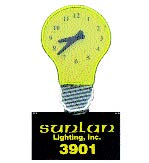“Sunlan Lighting—how may we light up your life?” To overhear Kay Newell, the Light Bulb Lady, answer the phone is to understand the very filament of her business.
In 1989, Newell opened the Sunlan Lighting, Inc. warehouse in a pair of turn-of-the-century two-story structures that once housed Stewart’s Variety Store and a meat market. The street was drugged, barred, boarded up, and desolate. The building itself had an old-growth-timber heart but not much else after three decades of vacancy, a fire, a leaking roof, and floorboards destroyed from the axe work of a butcher killing chickens years before. Fifteen years later, the neighborhood buzzes with circular saws priming new storefronts, and crackles with espresso energy rather than crack violence. And if you need to buy a light bulb, there is still no better place to go.
The majority of Kay Newell’s customers are commercial accounts—customers seeking an oddball bulb for a freezer case, or a peculiar snaking fluorescent. She carries some 20,000 bulbs in all styles, shapes, and sizes, including the orange flickering ones used for candelabra in haunted houses or seafood restaurants made to resemble ships’ galleys. The more run-of-the-mill bulbs belie their plain exteriors with 5,000 hours of industrial-strength burning-bright packed inside each; those that you would pick up at the grocery dim after 750. Some of her customers wander into the cluttered warehouse after having been everywhere else in town, cradling a burned-out bulb no bigger than a thumbnail.
“Lighting is extremely individual,” Newell tells me one day when I come in to Sunlan in search of a new light for my desk lamp. She points me to a display of three different types of bulbs down one of the aisles. “There’s a book over there. Hold that book under the first light,” she commands. I flip on the first switch and a plain sixty-watt bulb lights up. “Now, read out loud,” she says. “How do you feel? Listen to your body.”
I randomly open to page twenty-seven and mumble aloud text explaining the signs of a heart attack. I am embarrassed to read aloud. I am not relaxed. This light makes me feel bad and I turn it off. The next light displayed is a compact halogen: good morning light. Newell tells me she tried this for her bedside reading lamp, but it made her too jittery. It’s a nice, warm, yellow light. The third bulb is a neodymium full-spectrum bulb that replicates spring light. Cool. Calming. Replenishing. I’m not having a heart attack. I feel fine. “The only problem with those,” Newell smiles, “is that they’re addictive.” Even in a country that sells every consumer good imaginable, it’s hard to envision a store that just sells light bulbs. And yet that store fills a need—for the woman whose home is lit entirely by amber-colored bulbs, for the teacher who replaced her classroom’s dreary overhead fluorescents with full-spectrum bulbs, for that teacher’s students whose artwork periodically hangs in Sunlan’s display windows, along with a colored menagerie of bulbs dangling from strings, a large cat, and an oversized pair of light-bulb children enjoying tea parties and other such diversions.
Outside there is a display sign that reads “Sunlan Lighting, Inc.” in bright yellow letters, topped with a clock in the shape of a neon-rimmed light bulb. From its second-story perch, the sign is a beacon visible from blocks away. Newell designed it herself, the clock a natural response to years of working adjacent to a bus stop. No one ever seemed to know what time it was, and everyone asked.
DETAILS ABOUT MY LIGHT PURCHASE:
Bulbrite® Neodymium full-spectrum sixty-watt frosted bulb; Variety of uses including museums, galleries, jewelry stores, retail displays; Bulbrite Motto:“See Better… Feel Better”; Lasts 2,000–3,500 hours; Lumens: 6; Cost from Sunlan: $5; Bulbrite Industries, Inc. 145 W. Commercial Ave. Moonachie, NJ 07074; 1-800-528-5555





